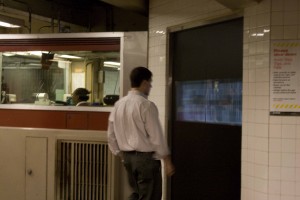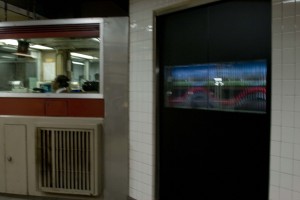There’s a lot of action on 42nd street and 6 Ave. No matter what season, day or fashion week it is.
But there’s something happening under Bryant Park as well, and unlike many mainstream exhibition spaces, to be able to see this work, you must move.
“Only by moving you see something happening. Not just shake your head left and right, but actually move about, change perspective to see the animation video,” says artist Eyal Ohana, one of the creators of Bryant Park in Motion.
In a city when everyone is in constant motion, Joshua Spodek, together with Ohana and three more NYU Tich students created the video installation in a busy public space; The 42nd St. Bryant Park subway station.
An LCD screen with 54 frames, compressed one next to the other in a way the viewer can’t really see them.
“Once you move, the light breaks and the images expand so you can actually see the movie,” Ohana tried to break the complicated mechanism down.
Yes, among other things Joshua Spodek is a physicist, and his company Submedia creates animated displays for transit systems. After producing successful ads that flicker through train tunnels and platform from Tokyo to Grand-Central, Spodek wanted to create a non-for profit project for New Yorkers.
Spodek came to the NYU Tisch School of the Arts Interactive Telecommunications Program (ITP) with the idea and the technology to recruit students that will provide the content.
“You can see simultaneously in one frame what’s happening underground and above the surface in Bryant Park,” said Ohana. “Above there are ice-skating, people, fashion shows, buildings, and an imaginary world underneath, with animals and mold.”
The active viewer
In a way, the young artist is presenting his installation in one of the city’s largest galleries, where thousands of people walk in and out of every day.
“The most interesting thing about this kind of work, is watching people’s reactions. You see people moving in different ways,” Ohana said.
These videos captured kids, parents and subway agents, reacting differently to his work.
Another example of an art piece that becomes animated is Masstransiscope, 1980 (Restored 2008) a work by Bill Brand on DeKalb Avenue.
Masstransiscope
It’s a different source of movement, but a similar effect. The hand painted panels provides the illusion of animation with lighting that occurs when the train is moving.
The idea of a still image that the viewer creates by moving to see the animation. Both are ideal, to be presented in the subway, where people are in motion one way or another.
Instead of having a mechanism that moves the images, the train plays that role as it moves you.
Living in New York for the past five years, Ohana is not only an artist, but a also commuter who appreciates these small underground surprises, courtesy of the Arts for Transit of the MTA.
“It’s the last place you expect to find those little jams, and it’s just fun. It turns a grey, boring wait, into something enjoyable, even uplifting. It’s added value to a time you have to kill anyways,” he said.
“What would be even more ideal is if they would divide the space between art and ads.”
There’s a social element to this kind of artwork. The setting is urban but it wants to make contact, to interact in a public space, and to entertain you – whoever you are and wherever you’re coming from.
So the next time you’re around 42nd Street and you’ve got a few minutes to kill, go underground. You don’t have to do anything, just don’t stand still.
Bryant Park in Motion

